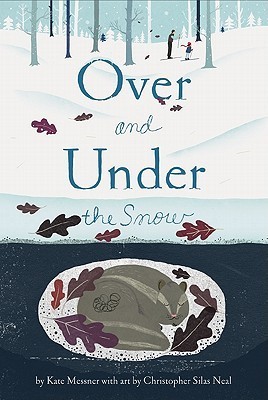KS1 book topic – Over and Under the Snow

Beneath the winter white crust of snow, there’s a hidden world of hibernating creatures for children to discover, says Sue Cowley…

- by Sue Cowley

Over and Under the Snow tells the story of a small girl and her father who are skiing home. As they pass through the woods, the girl spots lots of creatures that live above the snow – a red squirrel, a great-horned owl, a deer, and a bushy-tailed fox. Meanwhile, her father tells her about all the creatures that are hidden beneath the snow, in their ‘secret kingdom’ – shrews, deer mice, voles, bullfrogs, beavers, even bears.
It’s a delightful picture book that will entrance your children. Kate Messner’s story offers a perfect way into exploring habitats, and the icy illustrations by Christopher Silas Neal – with their subtle colour palette – could be used to inspire your children to create some wonderful wintry art, too.
Introducing the story
Before you read the story to your class, ask the children to think about all the different places where animals live. Use these questions to guide your discussion:
- What is a ‘habitat’?
- Can you name some different habitats?
- Do animals and birds always live in the same place all year round?
- What effect does the weather in an area have on where animals choose to live?
- Why do animals sometimes need to hide? How and where do they do this? (The children might bring up the concept of ‘camouflage’.)
- At what times of the year is it hardest for animals to find food and why?
Next, look at the cover of the book. What do the children think the story might be about, and how can they tell this from the cover? What information does the title of the story give them? Now read the book to your children and afterwards talk about the story together:
- In what country do you think the story is set?
- How does the father know what is under the snow?
- What different signs and senses do the girl and her father use to work out which creatures are in the environment around them?
- What does the father mean when he says “Tracks always tell a story”?
- Why do some animals hide away over winter?
- How does the fox find its prey under the snow? How can we tell?
- Why do you think the little girl imagines animal pictures drawn in the stars, in her dream?
1 | Secret Kingdoms – hunting for habitats
Take the children outside to look for some ‘secret kingdoms’ in your playground or local area. Encourage them to carefully lift up logs, or leaves, or rocks, to see what is hiding underneath. Look on tree trunks and up in the tree branches as well. The children could work in pairs and make notes, draw pictures or take photographs of what they find.
Make sure they understand that it is important to replace the logs, leaves or rocks after they have made their observations. If you have access to a pond, you could do some pond dipping as well, to see what creatures are hiding in the water.
Work with your children to identify as many of the creatures as possible. The Guide to Garden Wildlife (British Wildlife Publishing, 2008) has clear illustrations of all the different creatures they are likely to find in the UK. Now work together as a class to create a giant Secret Kingdom collage of all the different habitats you found, at different levels. You could gather leaves, twigs and other natural materials to add to your collage, to create a three-dimensional effect.
Creating a habitat Create your own habitat where wildlife can hide and hibernate, by making a bug hotel. The idea is to create an outdoor space with lots of different-sized hiding places, where insects, beetles, spiders, and other small creatures can hide over winter.
You can build your bug hotel using pallets, roof tiles, air bricks, twigs, hollow stems and canes, etc. You can find lots of advice about how to build a bug hotel on the internet.
Camouflage The snowshoe hare hides under a tree: she is ‘almost invisible’ because of her white coat. Talk with your children about the reasons why animals use camouflage: both to hide from predators, and also as a way to help them catch food, when hunting. Share some pictures of camouflaged animals with your class. Explain to your children that some animals change colour over the course of the seasons – why do they think animals would have evolved do this? You could also get your children to create some camouflage pictures or paintings of animals.
2 | Tracks always tell a story
Talk with the children about the tracks that the girl and her father find in the story. What does the author mean when she writes: “deep hoof prints punch through the crust”? What does this phrase tell us about the deer?
If the weather is snowy, a great activity is to go outside and look at all the different tracks animals and birds leave behind them in the snow. If there is no snow, you might also find tracks in soil or mud, for instance in your nature area.
What different animals can the children identify from the tracks they leave? How can we tell what kind of creature has left the tracks, just by looking at them? If we measure how far apart the tracks are, what does this tell us?
Get the children to create some ‘animal tracks’ of their own by dipping the feet of various toy animals into paint, and then pressing the feet down to make tracks across a large sheet of white paper. The children could also write a story, inspired by the phrase: “Tracks always tell a story.”
Finding food In the story, a red fox finds a mouse hiding under the snow. Re-read this section of the story to your class. How does the fox find the mouse? The story is not specific about the mouse’s fate – what do the children think happened to it – did it escape or not?
Look at the pictures of the fox in the book. What can children tell about which senses the fox uses, from the way it looks? (They might note the fox’s cup-shaped ears and its pointed nose.)
What other methods do animals use to find or store food over winter? What ways can we use to help animals survive the winter? You might place some bird-feeders in your nature area, and record the birds that visit to feed from them using photographs or tally charts.
Hibernation Talk with your children about hibernation – what it means, when it happens, and why some animals need to hibernate.
You might like to explain that the key features of a hibernating animal are that its breathing, body temperature and metabolism slow down, and that the main purpose of hibernation is to get through a period of food scarcity over the winter.
Can the children think of the names of any British creatures that hibernate? Which foods would be scarce during the winter months in the UK?
Here are a few fascinating facts to share with your children about hibernation:
- Bears in the far North can go without eating or drinking for up to eight months.
- During hibernation, the heartbeat of many animals falls to less than 10 beats a minute.
- Despite never having flown more than a few hundred metres before they leave, monarch butterflies migrate 2,000 miles south to hibernate.
- Scientists call the habitat under the snow the Subnivean Zone, which comes from the Latin for ‘under’ – sub – and ‘snow’ – nives. The snow acts as insulation for the animals that hide below.
3 | “Over and Under” – talking prepositions
Talk to your children about what a preposition is: can they spot a smaller word inside the word that will help them figure it out (‘position’)? The words ‘over’ and ‘under’ are both prepositions because they describe where the animals are in relation to the snow.
Towards the end of the story, the girl also snuggles “under the covers”. Talk about how it feels to hide underneath something – the children might use words such as “safe” and “secure”. Ask the children to create some “over” and “under” sentences of their own.
Alliteration Kate Messner uses lots of alliteration in her story: “frosted fresh”, “a flash of fur”, “leftover leaves”, “winter white”. As you read the story to the children, bring out the alliteration by emphasising the repeated consonant sounds. Ask the children to write an alliterative poem, on the subject of snow.
To help your children find and use a range of vocabulary you could:
- Make a list of ‘s’ words related to ‘snow’, ‘w’ words related to ‘white’, ‘c’ words related to ‘cold’ and ‘f’ words related to ‘frosty’.
- Encourage the children to come up with verbs, adverbs and adjectives as well as nouns.
- Split the children into groups and give each group a pad of sticky notes. Ask the children to write out the words on sticky notes, one word on each note. They can now experiment with creating alliterative phrases, by moving the sticky notes around – ‘whirling white wonderland’ or ‘soft soundless snow’.
- Ask the children to use some of these alliterative phrases to create their own winter poems.
4 | Winter wonderland – exploring the artwork
The illustrator of the book, Christopher Silas Neal, uses a subtle and limited palette of colours to create his winter landscape. Talk together about the artwork:
- Which colours has the artist chosen?
- Why do the children think he has picked these particular colours?
- What ‘feel’ or atmosphere do the colours give to the book?
- How does the artist create a sense of different textures?
- What interesting shapes can the children spot in the book (trees, snowflakes, leaves, etc)?
- How does the artist create the sense of a world hiding under the snow?
The colours and textures in the book are ones we would see in the natural world. Take your children outside to find samples of natural colours, materials and textures in the environment around them. Then, develop this into some artwork. The children could:
- Mix up paint colours to re-create the natural shades found outside.
- Create ‘snowflakes’ using the popular fold and cut out technique.
- Collect leaves with a variety of autumnal colours and use them to create a ‘Winter Woods’ collage.
- Do rubbings of various natural materials, to explore their textures.
- Experiment with cutting out different shapes to represent trees – some with bare branches, others conifers covered with snow (the classic ‘Christmas tree’ shape).











